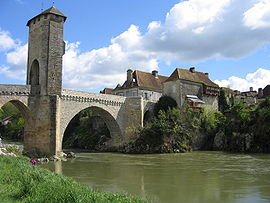- Orthez
-
Orthez
Bridge over the Gave de Pau Administration Country France Region Aquitaine Department Pyrénées-Atlantiques Arrondissement Pau Canton Orthez Intercommunality Canton of Orthez Mayor Bernard Molères
(2008–20014)Statistics Elevation 38–185 m (125–607 ft)
(avg. 62 m/203 ft)Land area1 45.86 km2 (17.71 sq mi) Population2 11,000 (2006) - Density 240 /km2 (620 /sq mi) INSEE/Postal code 64430/ 64300 1 French Land Register data, which excludes lakes, ponds, glaciers > 1 km² (0.386 sq mi or 247 acres) and river estuaries. 2 Population without double counting: residents of multiple communes (e.g., students and military personnel) only counted once. Coordinates: 43°29′21″N 0°46′11″W / 43.4891666667°N 0.769722222222°W
Orthez (Gascon Ortès) is a commune in the Pyrénées-Atlantiques department in south-western France.
It lies 40 km NW of Pau on the Southern railway to Bayonne. The town also encompasses the small village of Sainte-Suzanne thus residents of the town are called either Orthéziens or Sainte-Suzannais. The population figures from 1999 give the population of the commune at 10,121 and of the canton at 16,168. In 1906, the town had 4,159 and the commune had 6,254.
Contents
Administration
Orthez has a judicial court but not an appeals court. It was the seat of a subprefecture from 1800 until 1926 (the dates of the creation and abolition of the arrondissement (district) of Orthez).
Geography
Orthez straddles the westward-flowing Gave de Pau with most of the town proper lying on the right bank. However there are several residential developments and an industrial park on the left bank not to mention Sainte-Suzanne, an integral part of the town. A partially artificial lake called 'Lac de l'y grec' (usually just spelled 'Lac de l'Y' i.e. 'Y Lake') (43°29′52″N 0°46′9″W / 43.49778°N 0.76917°W) has a pleasant and scenic walking trail.
Sights
The Gave de Pau is crossed at this point by a 14th century bridge which has four arches and is surmounted at its centre by a tower. Several old houses, and a church of the 12th, 14th and 15th centuries are of some interest, but the most remarkable building is the Tour de Moncade (43°29′31″N 0°46′13″W / 43.49194°N 0.77028°W), a pentagonal tower of the 13th century, once the keep of a castle of the viscounts of Béarn, and now used as a meteorological observatory. A building of the 17th century is all that remains of the old Calvinist university (see below). The town hall is a modern building containing the library.
Economy
The spinning and weaving of cotton, especially of the fabric called toile de Béarn, flour-milling, the manufacture of paper and of leather, and the preparation of hams known as jambons de Bayonne and of other delicacies are among its industries. There are quarries of stone and marble in the neighborhood, and the town has a thriving trade in leather, hams and lime.
History
During the 12th century, Orthez was the capital of Béarn, after Morlaàs and before Pau which is still the prefectural administrative capital. At the end of the 12th century Orthez passed from the possession of the viscounts of Dax to that of the viscounts of Bearn, whose chief place of residence it became in the 13th century. Froissart records the splendour of the court of Orthez under Gaston Phoebus in the latter half of the 14th century. Jeanne d'Albret founded a Calvinist university in the town and Theodore Beza taught there for some time. An envoy sent in 1569 by Charles IX to revive the Catholic faith had to stand a siege in Orthez (battle of Orthez) which was eventually taken by assault by the Protestant/Huguenot captain, Gabriel, count of Montgomery. In 1684 Nicholas Foucault, intendant under Louis XIV, was more successful, as the inhabitants, ostensibly at least, renounced Protestantism, which is nevertheless still strong in the town. Another battle of Orthez occurred during the Napoleonic Wars on February 27, 1814 in which the Duke of Wellington defeated Marshal Soult on the hills to the north of Orthez. More recently Gaston Planté the French physicist was born here on the 22 April 1834, his major claim to fame was the invention in 1859 of the lead-acid battery, the common car battery.
Tour de France
Moments before the start of the 16th stage of the Tour de France from Pont-Neuf; signalled by the maire.
Orthez was the start of Stage 16 in the 2007 Tour de France.
Locale

Saint-Boès and Bonnut 
Baigts-de-Béarn, Salles-Mongiscard and Lanneplaà 
Sallespisse, Balansun and Castétis  Orthez/Sainte Suzanne
Orthez/Sainte Suzanne 

Ozenx-Montestrucq, Laà-Mondrans and Biron See also
References
- INSEE commune file
 This article incorporates text from a publication now in the public domain: Chisholm, Hugh, ed (1911). Encyclopædia Britannica (11th ed.). Cambridge University Press.
This article incorporates text from a publication now in the public domain: Chisholm, Hugh, ed (1911). Encyclopædia Britannica (11th ed.). Cambridge University Press.
External links
- (French) Gateway to Béarn of the Gaves : the cantons of Navarrenx, Orthez, Salies-de-Béarn and Sauveterre-de-Béarn.
Categories:- Communes of Pyrénées-Atlantiques
Wikimedia Foundation. 2010.



